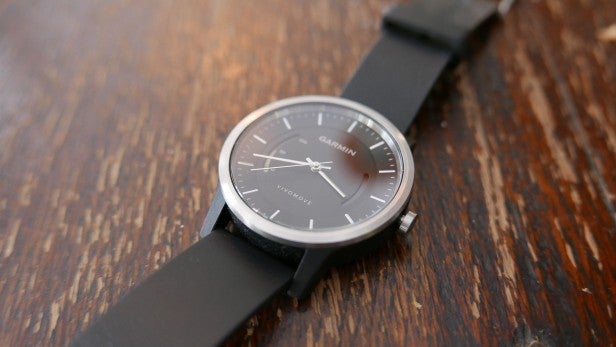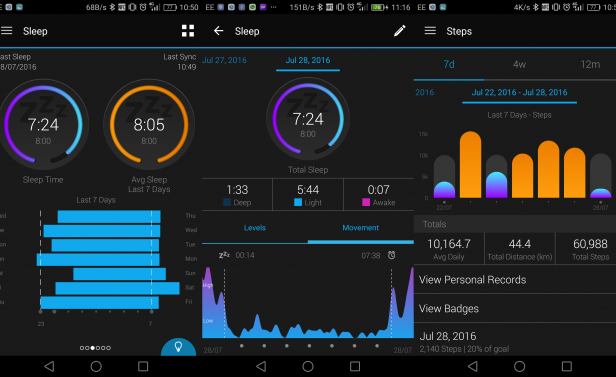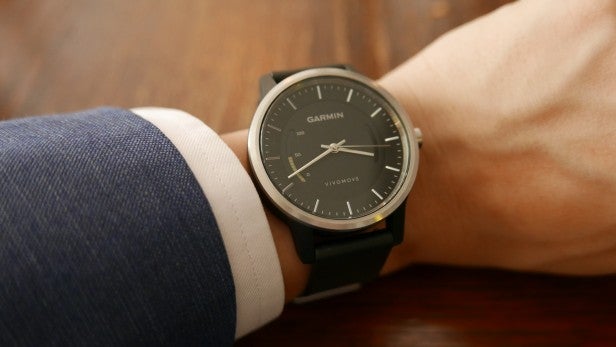Garmin Vivomove Review
Garmin Vivomove
Fancy a fitness tracker in disguise?

Verdict
Pros
- Stylish design
- Accurate sleep tracking
- Easy to track activity progress
- One-year battery life
Cons
- No vibration reminders and alarms
- No background syncing
- Hard to navigate app
Key Specifications
- Review Price: £139.00
- Step counter
- Sleep tracker
- 5ATM water resistance rating
- Replaceable 20mm bands
- Android and iOS app support
What is the Garmin Vivomove?
The Garmin Vivomove is a fitness tracker for those with more discerning aesthetic tastes. Like the Withings Activité range, it’s visually very much a watch first, activity tracker second. It won’t stick out like a sore thumb if you need to transition from an afternoon workout to an evening gala.
With its elegant design comes certain restrictions, though, so you can only expect basic step counting and sleep tracking. Those looking for more comprehensive fitness tracking will need to look elsewhere. But with its year-long battery and good looks, the Vivomove is a solid choice if you want a stylish tracker you can wear for every occasion.
Related: Best fitness trackers
Garmin Vivomove – Design and Setup

The Garmin Vivomove is available in a variety of finishes and designs, starting with the entry-level Sport (£139.99) available in black or white with an accompanying silicone sport band.
Then there’s the Classic (£179.99), again in black or white, but with a premium leather strap. The Classic white model also features a rose-gold bezel.
Finally, the range is rounded out with the Premium (£239.99). This is offered with the choice of either a stainless steel finish with a black watch face and leather band, or a gold-tone steel finish with a white watch face and leather band. With such a breadth of choice, chances are you can find one that suits your taste. The Vivomove takes conventional 20mm-width straps, so you can always swap out the standard bands yourself.

I reviewed the basic black Sport model. Taste is always subjective, especially when it comes to timepieces, but I was fond of the 42mm circular design. The contrasting silver against the black is attractive. The Garmin Vivomove very much looks like a regular watch, which might be precisely what you’re looking for. I had no qualms wearing it day to day, but also for more formal situations, such as a wedding I attended. It never felt out of place like a traditional tracker might.

It’s a little thick for my taste at 12mm, but it didn’t prove cumbersome. It’s only marginally thicker than the Withings Activité Pop.
So far everything sounds very much like the description of a standard watch. But look closer at the face and you’ll notice two progress bars towards the centre. The left is a meter that fills to 100% and progressively shows your step count.
The bar on the right, called the Move Alert, gradually fills in red to show your inactivity levels. The less you move, the more it fills up. When it gets full it’s time for you to walk around for a few minutes to make it reset again.

Unfortunately, with no vibration motor inside the watch, there’s no physical reminder that you need to get moving, which is pretty standard on most trackers. You have to remember to check the progress bar, which means you can go long periods without realising how idle you’ve been.
The Vivomove syncs with Garmin’s Connect app on Android or iOS. Pairing is easy, requiring you to just hold the crown for three seconds to put it into Bluetooth pairing mode. The app will then run you through the connection process to add the Vivomove as your activity tracker of choice.
Garmin Vivomove – Tracking and Software
Garmin uses the same Connect app across all of its fitness devices. One of reviews editor Alastair Stevenson’s complaints when reviewing the Garmin Forerunner 735XT was how convoluted and hard to navigate the app could be. Despite the Vivomove tracking considerably fewer activities than the 735XT, the app experience can feel just as confusing, as it uses the same interface.
While the Vivomove only tracks steps and sleep, there’s still a breadth of information and data tucked away – it can just be hard to find. The dark interface isn’t the most attractive, either, with information presented in a slightly overwhelming manner. Still, given some time to dig around, there are useful seven-day and month-long overviews of activities so you can see patterns emerge around activity and sleep.
Related: Best fun fitness apps
There’s no background syncing, so you need to manually sync the Vivomove with the app by pairing the devices. Most activity trackers, such as the Misfit Ray or Fitbit Charge HR, will automatically pair and begin syncing as soon as you open the app. Once syncing does begin, it can also be a little slow to complete.
As for tracking, whether running or sleeping, everything is automated. There’s zero need to ever interact with the watch itself, aside from changing the time. It means you can leave the Vivomove on and completely forget about it.

Over the course of a normal day there was about a 200-step difference compared to the Jawbone UP3 I wore simultaneously. Not the biggest difference I’ve seen considering the wildly different algorithms manufacturers use. Garmin Connect can be set to automatically adjust your step goal based on your activity levels.
There was a much bigger disparity when I went for a lunchtime run. The Jawbone UP3 logged a 5.78km run automatically, compared to 4.53km with the Garmin Vivomove. Having ran the route before using GPS, it’s much closer to 5km in reality, so the Vivomove was the more accurate of the two, although still questionably off the pace.
The Vivomove can be used for treadmill running, too, as the accelerometer is able to track distance. One area where the Withings Activité has the edge is that it can track swimming. While the Vivomove is 5ATM rated, so you can go to depths of 50m, it doesn’t actually track laps. You also won’t want to expose one with a leather strap to water for prolonged periods.

Sleep tracking was incredibly accurate, practically to the minute that I nodded off and arose the following morning. The sleep graph is broken down into deep, light and awake and, usefully, you can also view a graph mapping your movement level throughout the night. You’re able to then pinpoint when you toss and turn the most. It’s just a shame that the lack of a vibration motor rules out a silent alarm feature.
Garmin Vivomove – Battery and charging
The Vivomove uses a regular CR2025 coin cell battery and this should last for around a year. This is great, as you can then put the watch on and never have to take it off. There’s nothing worse than having to constantly charge an activity tracker, so this is a major positive.

Should I buy the Garmin Vivomove?
If you favour a stylish design and want an activity tracker you can put on and largely forget about, the Garmin Vivomove is a good choice. However, the Withings Activité Pop or Activité Steel are more fully featured, cheaper, and arguably have a sleeker, more unisex design. Withings’ inclusion of a silent alarm is useful, too. The Activité range is still our go-to recommendation for a watch-alike tracker.
Related: Best smartwatch
Verdict
A decent fitness tracker masquerading as a stylish traditional watch.
Watch: Trusted Explains – Wearables and Fitness Trackers


